Cotyledon barbeyi var. soutpansbergensis
Cotyledon barbeyi Schweinf. ex Baker var. soutpansbergensis Van Jaarsv. & A.E.van Wyk
Family: Crassulaceae
Common names: Soutpansberg cliff-cotyledon (Eng.), Soutpansberg krans-plakkie (Afr.)
Introduction
The Soutpansberg cliff-cotyledon is only known from cliffs along the northern foothills of the Soutpansberg, Limpopo Province, South Africa. It is a small, branched, cliff-squatting shrublet, with pale, whitish-green leaves and shiny, tubular, orange-red flowers. It is easily grown and makes a rewarding pot plant.
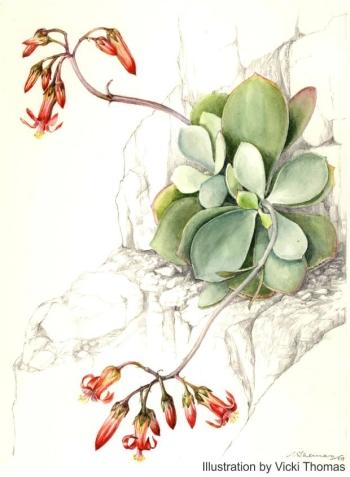
Fig. 1. An illustration of Cotyledon barbeyi var. soutpansbergensis by Vicki Thomas, from a plant growing on a cliff face at Wyllies Poort.
Description
Description
Ascending spreading, branched, dwarf-sized, compact shrublet, up to 100 mm tall. Branches 5–7 mm in diameter at base Bark brownish grey. Leaves hairless (glabrous), 25–40 × 17–25 mm, oblanceolate. The upper surface flat, pale whitish-green, covered with a powdery bloom. The leaf margin is reddish and the leaf tips bears a short, small point (mucronate). The leaf base is wedge-shaped (cuneate) with a short petiole. The inflorescence is an ascending spreading thyrse to 100 mm tall, bearing branches with 3-5 groups of flowers (dichasia). The peduncle with 1 or 2 pairs of bracts. The calyx lobes green, 6 × 4 mm. The flower (corolla) is tubular, orange-red, 20 mm long, the tube 14–18 mm long. The flowers and pedicels sparsely glandular hairy. The base with 5 inflated bulges in between the calyx lobes. Each of these bulges 5 mm long. The floral lobes are free for about 15 mm, recurved at the tips. The stamens exserted for 5–14 mm, fused to base of corolla, in 2 whorls and free for about 22 mm. The anthers yellow, spherical. The nectar glands (squamae) are spreading, oblong, 4–5 × 1.5 mm, yellowish-green. The carpels tapering, decurrent on styles, 28 mm long. Flowering time is in mid-winter (June to September).
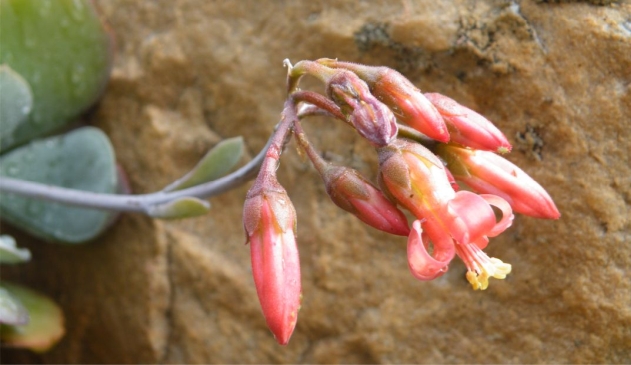
Fig. 2. Cotyledon barbeyi var. soutpansbergensis in flower at Kirstenbosch National Botanical Garden, showing the sideways projection of the inflorescence, unlike the erect inflorescence of the var. barbeyi.
Conservation Status
Status
Cotyledon barbeyi var. soutpansbergensis is Critically Rare and only known from dry cliff-faces along the lower northern slopes of the Soutpansberg. Due to its safe, inaccessible habitat, it is not threatened.
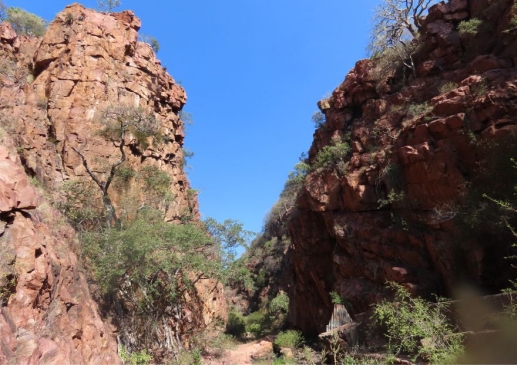
Fig. 3. Wyllies Poort, northern foothills of the Soutpansberg in the Limpopo Province of South Africa, habitat of Cotyledon barbeyi var. soutpansbergensis.
Distribution and habitat
Distribution description
Cotyledon barbeyi var. soutpansbergensis is confined to sheer cliffs along the dry river valleys of the lower northern foothills of the Soutpansberg, Limpopo Province. Although plants are difficult to reach, they can be viewed from the cliff base. They grow in rocky pockets, ledges and crevices on west-facing cliffs. The geology consists of hard quarzitic sandstone rocks of the ancient (Protozoic) Soutpansberg Group, Wyllies Poort Formation (Barker et al. 2006).
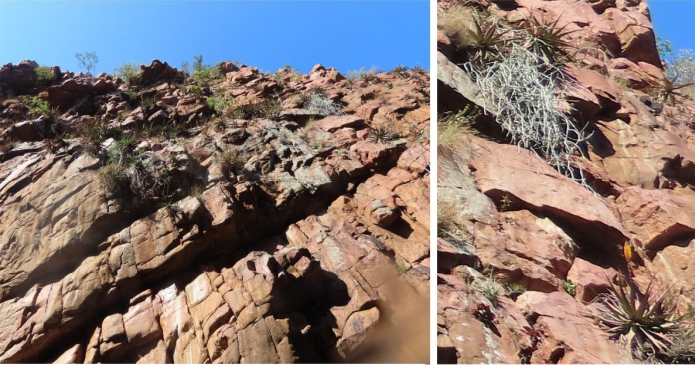
Fig. 4. The west facing cliff face at Wyllies Poort, Soutpansberg, habitat of Cotyledon barbeyi var. soutpansbergensis. Note the large Aloe spicata also growing on the cliffs, and the rope-like stems of Cynanchum viminale.
The vegetation in the habitat of Cotyledon barbeyi var. soutpansbergensis consists of Soutpansberg Mountain Bushveld (Mucina et al 2006) and part of the Savanna Biome. The climate is hot throughout the year but cooler during the winters when the days are shorter. Temperature can often go up to 40°C. Average daily maximum temperature is about 29°C and average daily minimum 17°C. Rainfall occurs mainly in summer, ranging from 350–400 mm per annum, mainly in thunder showers. Plants grow at an altitude of 400–600 m. Associated cliff-dwelling succulents in the habitat of Cotyledon barbeyi var. soutpansbergensis include: Adromischus umbraticola, Aloe petrophila, Aloe spicata, Anacamperos subnuda, Coleus cylindraceus, Crassula perfoliata var. heterotricha, Crassula setulosa, Crassula swaziensis, Kalanchoe sexangularis, Portulacaria afra, Cynanchum viminale and Pouzolzia mixta var. mixta. Plants also share their habitat with rock-dwelling fig species such as Ficus tettensis, F. salicifolia, F. ingens and F. glumosa.
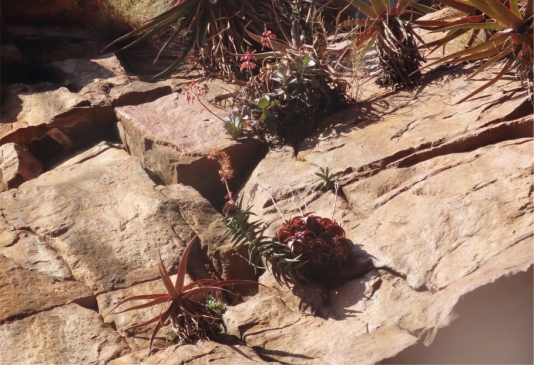
Fig. 5. Cotyledon barbeyi var. soutpansbergensis in flower in July 2022 in Wyllies Poort. Note the other cliff-dwellers which include Aloe spicata, Aloe petrophila, Kalanchoe sexangularis and Crassula perfoliata var. heterotricha.
Derivation of name and historical aspects
History
Cotyledon barbeyi var. soutpansbergensis was named by Braam van Wyk and the author in Aloe magazine in 2012 (Van Jaarsveld & Van Wyk 2012).The author visited Wyllies Poort, along the northern foothills of the Soutpansberg, on 3 July 2003, as part of his research on succulent plants confined to southern African cliffs (obligatory cremnophytes). Our mission was to find and study cliff-dwelling succulent plants, in particular Aloe petrophila, in their cliff habitat. This small, rare Aloe with spotted leaves, is one of the smallest of the Aloe maculata group, and is only known from cliffs along the northern foothills of the Soutpansberg.

Fig. 6. Cotyledon barbeyi var. soutpansbergensis in flower on a cliff in Wyllies Poort, July 2022.
I was assisted by my colleagues Freddie van Wyk and Phakamani Xaba, and my family. The crevice cliff habitat was reached by abseiling, and among the Aloe petrophila plants, we noticed a small, grey-leaved Cotyledon. Vegetative material was collected for propagation and plants were grown in the Kirstenbosch nursery. The small stature of the plant, together with its ascending spreading inflorescence, differs from the widespread Cotyledon barbeyi, and it was decided to give it varietal status. Flowering plants were given to Vicki Thomas, who made the illustration (Fig. 1) and the description was drawn up.
Cotyledon barbeyi var. soutpansbergensis is growing at both Kirstenbosch National Botanical Garden (681/09), and at Babylonstoren Farm. Here the plant regularly flowers in winter (June to September in the southern Hemisphere). The bulge between the calyx lobes shows it belongs in C. barbeyi, but here the resemblance ends. The plant remains small and the inflorescence is ascending spreading, unlike the erect inflorescence of var. barbeyi. In general it is smaller than C. orbiculata and the latter lacks the bulge between the sepal lobes.
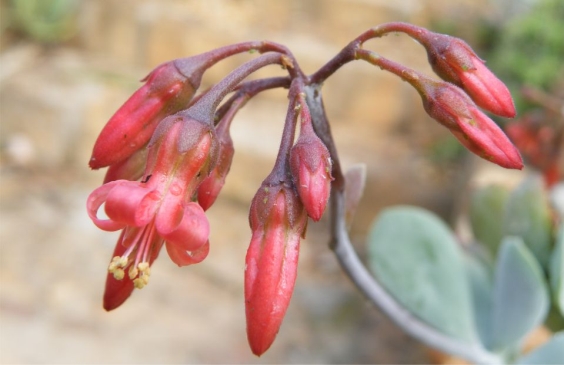
Fig. 7. The flowers of Cotyledon barbeyi var. soutpansbergensis, note the bulge between they calyx lobes.
Cotyledon barbeyi var. barbeyi is a variable and widespread species which grows from the Arabian Peninsula to the Limpopo Province. It can grow up to 3 m tall and is one of the tallest within the genus Cotyledon. The other tall shrubby species include C. velutina from the Eastern Cape, a species adapted to dense thicket vegetation. The inflorescence of C. barbeyi var. barbeyi grows erect and much taller than in the var. soutpansbergensis. The leaves of C. barbeyi var. barbeyi are very variable, some populations with sub-terete linear leaves, whilst others have greenish flat leaves.
The genus Cotyledon was established by Linnaeus in 1753, revised by Toelken in 1985 and also treated by the author in the Illustrated Handbook of Succulent Plants (Crassulaceae) (Eggli, 2003) and in Tylecodon and Cotyledon (Van Jaarsveld & Koutnik 2004). The genus Cotyledon consists of 18 recognized species .
Ecology
Ecology
Cotyledon barbeyi var. soutpansbergensis flowers mainly in mid-winter and is pollinated by sunbirds. It has been introduced to Babylonstoren Farm where plants can be observed in the succulent house at Babylonstoren Farm growing in ceramic containers and pollinated by the malachite and double-collared sunbirds. Once pollinated the spreading pendent flowers become erect and the seed is dispersed by gusts of wind on the cliff. The lower northern slopes in the Soutpansberg are very hot and dry during the winters and rainfall is sparse. The pruinose nature and production of anthocyanins (reddish colour under dry conditions) in the leaves suggest a response to the xeric, hot, cliff-face habitat, reducing penetration of excessive light. Small wonder that the vegetative parts (leaves and stems) are covered with a powdery bloom, reducing the effects of sun exposure. The succulent leaves help it survive in its extreme cliff face habitat. Three succulent growth forms on cliffs have been identified, the cliff-hangers, (e.g. Cotyledon pendens), cliff huggers ( e.g. Adromischus umbraticola) and the cliff squatters, which are solitary shrublets of which Cotyledon barbeyi var. soutpantsbergensis and Cotyledon tomentosa subsp. tomentosa are examples.

Fig. 8. The grey-green, obovate leaves of Cotyledon barbeyi var. soutpansbergensis are covered in a powdery bloom, which aids in reducing the buildup of heat from sun exposure.
Cotyledon barbeyi var. soutpansbergensis grows out of reach of most of the larger herbivores. Tortoises often graze species of Cotyledon and in this region there are two species of tortoise, the larger leopard tortoise (Stigmochelys pardalis) and the smaller hinge-backed tortoise (Kinixys belliana). Cotyledons are known for their chemical defences (cotyledontoxins), possessing alkaloids which can kill warm-blooded animals (Watt & Breyer-Brandwijk 1962), however they are a favoured food of the leopard tortoise (Stigmochelys pardalis) and angulate tortoises (Chersina angulata). Because of its cliff habitat, out of the reach of larger herbivores, it would be interesting to investigate its toxicity to see if there is a reduction in alkaloids.
Uses
Use
Apart from growing it as an ornamental, not other cultural or medicinal uses have been recorded.
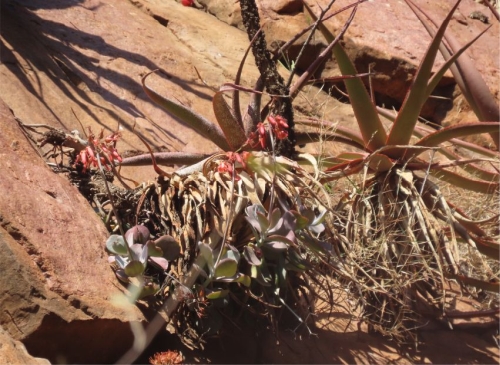
Fig. 9. Cotyledon barbeyi var. soutpansbergensis in flower, growing with Aloe spicata on a cliff in Wyllies Poort, July 2022.
Growing Cotyledon barbeyi var. soutpansbergensis
Grow
The Soutpansberg cliff-cotyledon, like most cotyledons, is easily grown, best suited to bushveld gardens but also suitable for dry semi-arid savanna and Mediterranean climate gardens. However when planted under normal garden conditions, due to competition from other faster and more aggressively growing species, it is soon overgrown and suffocated. Therefore it is best to grow them in a container on a stoep or windowsill. Compared to other species of Cotyledon it has a slower growth rate but eventually forms a branched shrublet to 20 cm high. Plant in a sunny, well-drained site, preferably in pockets created by an artificial rockery. Plants will also grow in hanging baskets. Cotyledon barbeyi var. soutpansbergensis can also be grown in some shade and plants look at their best when grown in groups. Water well during summer and autumn and less so during winter and early spring. Adding a organic fertilizer to the watering, enhances their growth performance. The Soutpansberg cliff cotyledon has been grown with success in the Babylonstoren Succulent House and is not shy to flower during the winter, when the plants can be viewed.
Propagate from cuttings, about 3-8 cm in length. Remove lower leaves and root in sand in spring. Plants are slow growing but will grow into an attractive plant with its pale leaves and shiny, orange-red flowers.
References
- Barker, O.B. et al. 2006. The Soutpansberg and Waterberg groups and the Blouberg Formation In: M.R. Johnson et al. (eds.), The geology of South Africa. Geological Society of South Africa. Johannesburg/Council for Geoscience, Pretoria, 301-318.
- Clarke, H. & Charters, M. 2016. The illustrated dictionary of southern African plant names. Flora & Fauna Publications Trust, Jacana, Johannesburg.
- Eggli, U. (ed.) 2003. Illustrated handbook of succulent plants: Crassulaceae. Springer, Berlin.
- Jacobsen, N. 2017. Eine Neuebewertung des Status von Cotyledon orbiculata var. spuria (L.) Toelken. Avonia 35(2): 198–201.
- Mucina, L. & Rutherford, M.C. (eds) 2006. The vegetation of South Africa, Lesotho and Swaziland. Strelitzia 19. South African National Biodiversity Institute, Pretoria.
- Nienaber, G.S. & Raper, P.E. 1983. Hottentot (Khoekhoen) place names. Butterworth Publishers, Durban.
- Tölken, H.R. 1985. Crassulaceae. In: O.A. Leistner (ed). Flora of southern Africa 14(1):1-244. Botanical Research Institute, Pretoria.
- Tölken, H.R. 1978. New taxa and new combinations in Cotyledon and allied genera. Bothalia 12(3): 377–393.
- Tölken, H.R. 1979. A re-evaluation of the Cotyledon orbiculata complex. Bothalia 12(4): 615–620.
- Van Jaarsveld, E.J. & Koutnik, D. 1997. New Cotyledon and Tylecodon species (Crassulaceae) from the Cape Province. Bradleya 15: 65–72.
- Van Jaarsveld, E. & Koutnik, D. 2004. Cotyledon and Tylecodon. Umdaus Press, Hatfield, Pretoria.
- Van Jaarsveld, E.J. 2015. Cotyledon gloeophylla, a new species from the Kouga River, Eastern Cape. Bradleya 33: 180–184.
- Van Jaarsveld, E.J. 2017. Cotyledon egglii, a new species from the Barberton region, Mpumalanga, South Africa. Bradleya 35: 179–184.
- Van Jaarsveld, E.J. & Eggli, U. 2017. Correction of a nomenclatural problem in Cotyledon. Bradleya 35: 71.
- Van Jaarsveld, E.J. 2015. Cotyledon woodii subsp. cremnophila, a new cliff dwelling taxon from the Kei River, Eastern Cape, Republic of South Africa. Haseltonia 21: 77–79.
- Van Jaarsveld, E.J. 2015. Cotyledon petiolaris, a new cliff-dwelling species from the Eastern Cape South Africa. Bradleya 33: 21–16.
- Van Jaarsveld, E.J. & Raimondo, D. 2014. Cotyledon barbeyi Schweinf. ex Baker var. soutpansbergensis Van Jaarsv. & A.E.van Wyk. National Assessment: Red List of South African Plants version 2020.1. Accessed on 2023/03/13.
- Van Jaarsveld, E.J. & Van Wyk, A.E. 2017. Cotyledon barbeyi var. soutpansbergensis, a new cliff-dwelling succulent from Limpopo, South Africa. Aloe 47(1):18–20.
- Van Jaarsveld, E.J. 1994. The distribution of Tylecodon and Cotyledon (Crassulaceaea) in south Arica and Namibia, pp. 1157–1163. In: Proceedings of the 13th Plenary Meeting of AETFAT Congress, Zomba, Malawi.
- Van Jaarsveld, E.J. 2003. New cliff-dwelling Crassulaceae from the Eastern Cape: a new Cotyledon and two new Adromischus taxa from the Mbashe and Mzimvubu Rivers, South Africa. Aloe 40: 2: 36–39.
- Van Jaarsveld, E.J. 2010. Waterwise gardening in South Africa and Namibia. Struik, Cape Town.
- Van Wyk, A.E. & Smith, G.F. 2001. Regions of floristic endemism in South Africa. A review with emphasis on succulents. Umdaus Press, Hatfield, Pretoria
- Watt, J.M. & Breyer-Brandwijk, M.G. 1962. The medicinal and poisonous plants of southern and eastern Africa , edn 2. Livingstone, Edinburgh & London.
Credits
Ernst van Jaarsveld
Kirstenbosch National Botanical Garden (Retired 2015)
Babylonstoren Farm
Extraordinary senior lecturer and researcher,
Department of Biodiversity and Conservation, University of the Western Cape
March 2023
Plant Attributes:
Plant Type: Shrub, Succulent
SA Distribution: Limpopo
Soil type: Sandy, Loam
Flowering season: Spring, Winter
PH:
Flower colour: Red, Orange
Aspect: Full Sun, Morning Sun (Semi Shade), Afternoon Sun (Semi Shade)
Gardening skill: Easy
Special Features:
Horticultural zones







Rate this article
Article well written and informative
Rate this plant
Is this an interesting plant?
Login to add your Comment
Back to topNot registered yet? Click here to register.